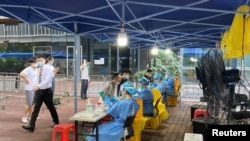China's southern tech hub of Shenzhen said it will adopt tiered antivirus restriction measures starting Monday, while the southwestern metropolis of Chengdu announced an extension of lockdown curbs, as the country grapples with fresh outbreaks.
Shenzhen, which went into a weekend lockdown Saturday, announced a new round of COVID-19 testing and vowed to "marshal all available resources, mobilize all forces, and take all possible measures" to stamp out the pandemic.
Separately, Chengdu, which placed its 21 million people under lockdown Thursday, said the city will keep curbs in place for most of the city, and will conduct more mass testing from Monday to Wednesday.
China is sticking to its stringent zero-COVID policy, even as most other countries have relaxed restrictions and chosen to live with the virus. As a result, fresh outbreaks have become a major risk to the world's second-biggest economy.
Currently, 33 cities are under partial or full lockdowns, affecting more than 65 million residents, according to an estimate by Chinese financial magazine Caixin.
In Shenzen, a city of 18 million people, an official said the risks were still considerable.
"Currently, the city's COVID situation is severe and complex. The number of new infections remains relatively high and community transmission risk still exists," Lin Hancheng, a Shenzhen public health official, told a news conference Sunday.
The city reported 89 new locally transmitted COVID infections for Sept 3, compared with 87 a day earlier.
Based on the results of the weekend testing, Shenzhen will classify its areas into three categories, reflecting low, medium and high risk of infection, Lin said.
In areas deemed low risk, the city will remove restrictions that confined much of its population to residential compounds over the weekend, though lockdowns will remain in place in 'high' and 'medium' risk neighborhoods.
In areas where infections were found, temporary restrictions would be prolonged for three days.
Major districts of Futian, Nanshan and Longhua said that entertainment centers like cinemas and KTVS would remain closed, and restaurants would allow dining in at half capacity.
The Nanyuan neighborhood of the Futian District will continue to be treated as a medium-risk area due to the relatively high number of positive cases detected, Lin said.
Separately, Chengdu, the capital city of Sichuan Province, said it will continue to impose COVID lockdown curbs in most of the city.
Even in two areas where life was allowed to come back to normal — Xinjin District and Qionglai City — indoor dining will continue to be banned, while public activities such as conferences and performances will be strictly restricted.







